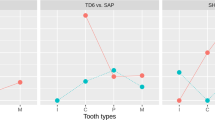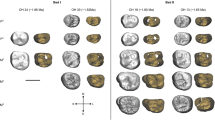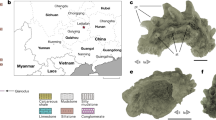Abstract
A modern human-like sequence of dental development, as a proxy for the pace of life history, is regarded as one of the diagnostic hallmarks of our own genus Homo1,2,3. Brain size, age at first reproduction, lifespan and other life-history traits correlate tightly with dental development4,5,6. Here we report differences in enamel growth that show the earliest fossils attributed to Homo do not resemble modern humans in their development. We used daily incremental markings in enamel to calculate rates of enamel formation in 13 fossil hominins and identified differences in this key determinant of tooth formation time. Neither australopiths nor fossils currently attributed to early Homo shared the slow trajectory of enamel growth typical of modern humans; rather, both resembled modern and fossil African apes. We then reconstructed tooth formation times in australopiths, in the ∼1.5-Myr-old Homo erectus skeleton from Nariokotome, Kenya7, and in another Homo erectus specimen, Sangiran S7-37 from Java8. These times were shorter than those in modern humans. It therefore seems likely that truly modern dental development emerged relatively late in human evolution.
This is a preview of subscription content, access via your institution
Access options
Subscribe to this journal
Receive 51 print issues and online access
$199.00 per year
only $3.90 per issue
Buy this article
- Purchase on Springer Link
- Instant access to full article PDF
Prices may be subject to local taxes which are calculated during checkout


Similar content being viewed by others
References
Bermudez De Castro, J. -M. et al. A modern human pattern of dental development in Lower Pleistocene hominids from Atapuerca-TD6 (Spain). Proc. Natl Acad. Sci. USA 96, 4210–4213 (1999).
Wood, B. & Collard, M. The human genus. Science 284, 65–71 (1999).
Moggi-Cecchi, J. in The Origin of Humankind (eds Aloisi, M., Battaglia, B., Carafoli, E. & Danieli, G. A.) 35–50 (IOS, Amsterdam, 2000).
Smith, B. H. Dental development as a measure of life history in primates. Evolution 43, 683–688 (1989).
Allman, J. & Hasenstaub, A. Brains, maturation times, and parenting. Neurobiol. Aging 20, 447–454 (1999).
Kelley, J. in Human Evolution through Developmental Change (eds McNamara, K. J. & Minugh-Purvis, N.). (Johns Hopkins Univ. Press, Baltimore, in the press).
Walker, A. & Leakey, R. The Nariokotome Homo erectus Skeleton (Harvard Univ. Press, Cambridge, Massachusetts, 1993).
Grine, F. E. & Franzen, J. L. Fossil hominid teeth from the Sangiran Dome (Java, Indonesia). Courier Forschungsinstitut Senkenberg 171, 75–103 (1994).
Bromage, T. G. Enamel incremental periodicity in the pig-tailed macaque: A polychrome fluorescent labelling study of dental hard tissues. Am. J. Phys. Anthropol. 86, 205–214 (1991).
FitzGerald, C. M. Do enamel microstructures have regular time dependency? Conclusions from the literature and a large scale study. J. Hum. Evol. 35, 371–386 (1998).
Antoine, D., Dean, C. & Hillson, S. in Dental Morphology 1998 (eds Mayhall, J. T. & Heikkinen, T.) 48–55 (Oulu Univ. Press, Finland, 1999).
Beynon, A. D. & Dean, M. C. Crown formation time of a fossil hominid premolar tooth. Arch. Oral Biol. 32, 773–780 (1987).
Beynon, A. D., Dean, M. C., Leakey, M. G., Reid, D. J. & Walker, A. Comparative dental development and microstructure of Proconsul teeth from Rusinga Island, Kenya. J. Hum. Evol. 35, 163–209 (1998).
Dean, M. C., Beynon, A. D., Thackeray, J. F. & Macho, G. A. Histological reconstruction of dental development and age at death of a juvenile Paranthropus robustus specimen, SK 63, from Swartkrans, South Africa. Am. J. Phys. Anthropol. 91, 401–419 (1993).
Boyde, A. in Primate Life History and Evolution (ed. DeRousseau, J.) 229–267 (Wiley-Liss, New York, 1990).
Risnes, S. Growth tracks in enamel. J. Hum. Evol. 35, 331–350 (1998).
Schwartz, G. T. Taxonomic and functional aspects of the patterning of enamel thickness distribution in extant large-bodied hominoids. Am. J. Phys. Anthropol. 111, 221–240 (2000).
Beynon, A. D. & Wood, B. A. Variations in enamel thickness and structure in East African hominids. Am. J. Phys. Anthropol. 70, 177–193 (1986).
Grine, F. E. & Martin, L. B. in Evolutionary History of the Robust Australopithecines (ed. Grine, F. E.) 3–42 (Aldine de Gruyter, New York, 1988).
Smith, B. H. Patterns of dental development in Homo, Australopithecus, Pan and Gorilla. Am. J. Phys. Anthropol. 94, 307–325 (1994).
Beynon, A. D. & Dean, M. C. Distinct dental development patterns in early fossil hominids. Nature 335, 509–514 (1988).
Dean, M. C. Progress in understanding hominoid dental development. J. Anat. 197, 77–101 (2000).
Bromage, T. G. & Dean, M. C. Re-evaluation of the age at death of immature fossil hominids. Nature 317, 525–527 (1985).
Schwartz, G. T., Reid, D. J. & Dean, M. C. Developmental aspects of sexual dimorphism in hominoid canines. Int. J. Primatol. 22, 837–860 (2001).
Lovejoy, C. O., Cohn, M. J. & White, T. D. Morphological analysis of the mammalian postcranium: A developmental perspective. Proc. Natl Acad. Sci. USA 96, 13247–13252 (1999).
Jernvall, J. & Han-Sung, J. Genotype, phenotype and developmental biology of molar tooth characters. Yearb. Phys. Anthropol. 43, 171–190 (2000).
Wood, B. A. Hominid Cranial Remains Koobi Fora Research Project Vol. 4. (Clarendon, Oxford, 1991).
Ramirez Rozzi, F. V. Can enamel microstructure be used to establish the presence of different species of Plio-Pleistocene hominids from Omo, Ethiopia? J. Hum. Evol. 35, 543–576 (1998).
Smith, B. H. & Tompkins, R. L. Towards a life history of the Hominidae. Ann. Rev. Anthropol. 24, 257–279 (1995).
Reid, D. J. & Dean, M. C. The timing of linear hypoplasias on human anterior teeth. Am. J. Phys. Anthropol. 113, 135–139 (2000).
Acknowledgements
We thank The Government of Kenya; The National Museums of Kenya; Forschungsinstitut Senckenberg, Frankfurt am Main, Germany; the Natural History Museum, London; and F. Thackeray of the Transvaal Museum, South Africa for access to fossil material. We thank D. Antoine, B. Berkovitz, D. Beynon, D. Clements, C. FitzGerald, L. Humphrey, J. Jernvall, J. Kelley, C. Kiarie, R. Krusynski, D. Lieberman, G. Macho, P. O'Higgins, J. Pendjiky, F. Ramirez Rozzi, H. Smith, P. Smith, F. Spoor, P. Walton and B. Wood for their help. This research was enabled by research grants to C.D. from the Royal Society and the Leverhulme Trust.
Author information
Authors and Affiliations
Corresponding author
Rights and permissions
About this article
Cite this article
Dean, C., Leakey, M., Reid, D. et al. Growth processes in teeth distinguish modern humans from Homo erectus and earlier hominins. Nature 414, 628–631 (2001). https://doi.org/10.1038/414628a
Received:
Accepted:
Issue Date:
DOI: https://doi.org/10.1038/414628a
This article is cited by
-
Dietary strategies of Pleistocene Pongo sp. and Homo erectus on Java (Indonesia)
Nature Ecology & Evolution (2023)
-
Fossil Primate Teeth as an Archive for High Resolution Ontogenic, Dietary and Palaeoclimate Record
Journal of the Geological Society of India (2022)
-
Middle Pleistocene hominin teeth from Biache-Saint-Vaast, France
Archaeological and Anthropological Sciences (2022)
-
A universal power law for modelling the growth and form of teeth, claws, horns, thorns, beaks, and shells
BMC Biology (2021)
-
Insights into the palaeobiology of an early Homo infant: multidisciplinary investigation of the GAR IVE hemi-mandible, Melka Kunture, Ethiopia
Scientific Reports (2021)
Comments
By submitting a comment you agree to abide by our Terms and Community Guidelines. If you find something abusive or that does not comply with our terms or guidelines please flag it as inappropriate.



